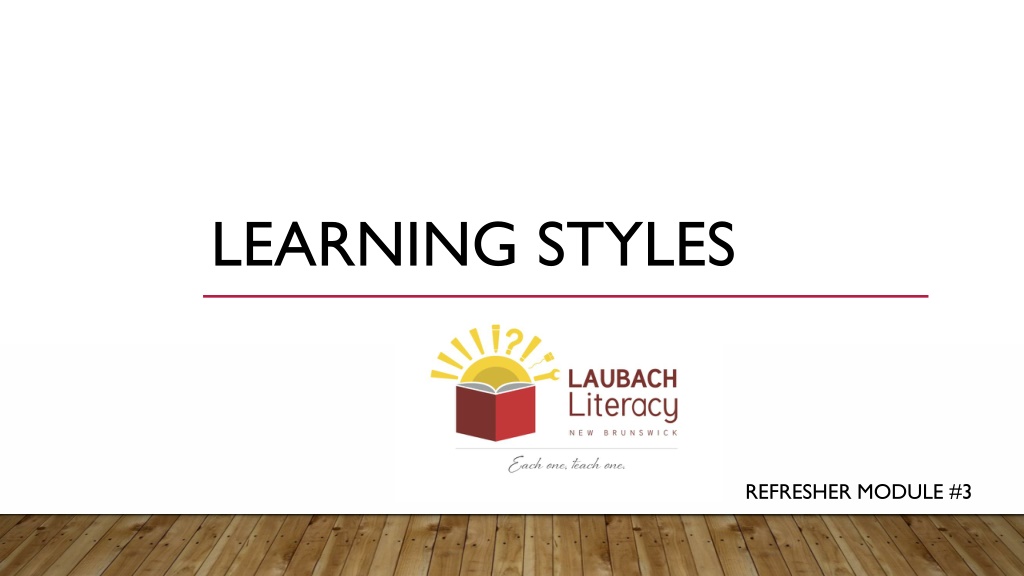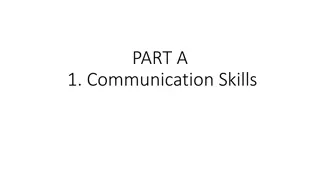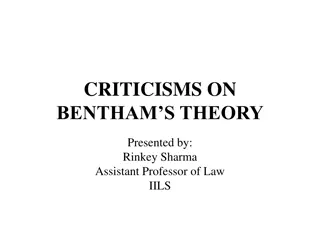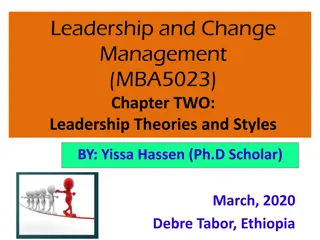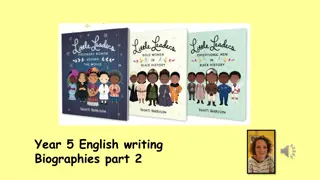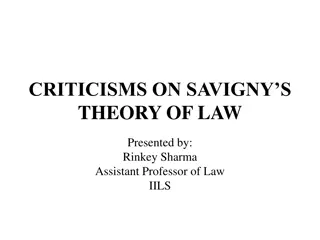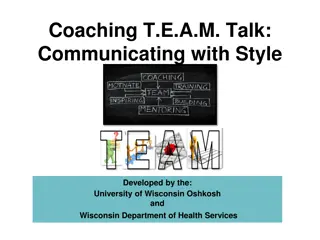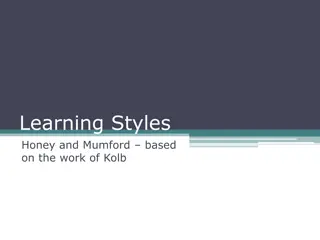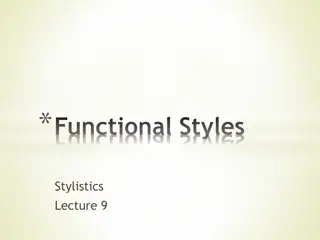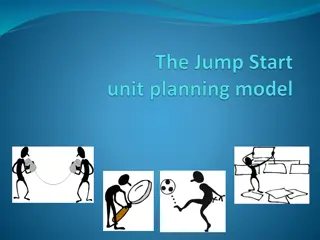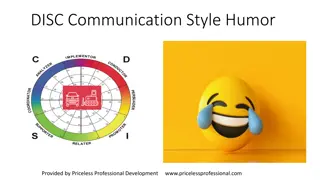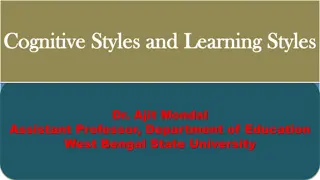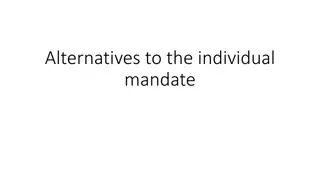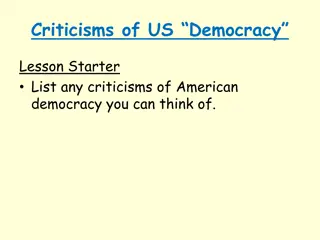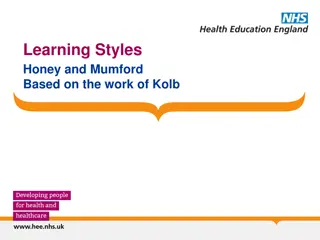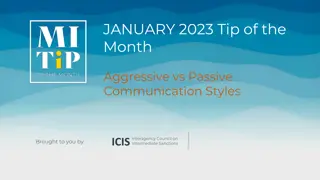Understanding Learning Styles and Criticisms: A Comprehensive Overview
Delve into the concept of learning styles, explore different approaches, and learn how to incorporate visual, auditory, and kinesthetic learning in lesson planning. Uncover the controversies surrounding learning styles, criticisms against fixed style theories, and insightful discussions on matching teaching styles. Enhance your understanding of learning channels, preferences, and scoring methods to optimize learning effectiveness.
Download Presentation

Please find below an Image/Link to download the presentation.
The content on the website is provided AS IS for your information and personal use only. It may not be sold, licensed, or shared on other websites without obtaining consent from the author. Download presentation by click this link. If you encounter any issues during the download, it is possible that the publisher has removed the file from their server.
E N D
Presentation Transcript
LEARNING STYLES REFRESHER MODULE #3
OBJECTIVES Introduce the concept of learning styles and the controversy Understand the characteristics of different learning approaches How to incorporate visual, auditory and kinesthetic/tactile learning in our lesson planning
LEARNING STYLES PROCEED WITH CAUTION
THE CRITICISMS 1. The Science Isn't Strong Enough - We may express our preferences about how we learn, but they're not necessarily an accurate reflection of how our brains work. 2. Learning Styles Change - Attempts to "diagnose" someone's learning style once and for all will likely fail. 3. Strengths and Preferences Are Not the Same An article in the Journal of Educational Psychology revealed big differences between people's assessed strengths, and how they actually tackled learning tasks in practice. 4. Teaching to Particular Learning Styles Doesn't Work For psychologist Scott Lilienfeld, the idea that "students learn best when teaching styles are matched to their learning styles" is one of the 50 Great Myths of Popular Psychology.
USING LEARNING STYLES THEORIES
BARSCH LEARNING STYLES - QUESTIONS
SCORING THE FORM
3 5 3 CAROL S ANSWERS 1 3 5 3 5 3
5 3 3 3 3 5 1 5 3 CAROL S SCORE 11 11 9
LEARNING CHANNELS INVENTORY Points Value 3 Often 2 Sometimes 1 - Seldom
SCORING THE LEARNING CHANNELS INVENTORY 2 1 3 2 2 10 2 1 1 3 1 8 3 2 3 1 3 12 Kinesthetic/Tactual
PREFERENCE - AUDITORY Characteristics: Learning Strengths Enjoy talking Remember what they hear and say Like to discuss things Can recall information after hearing it a few times Prefer oral reading Like phonics Can remember oral instructions well Find sounds distracting Understand information best when they HEAR it Move lips when reading Like to make noise Easily distracted
TUTORING TIPS - AUDITORY Record spelling words on tape Give oral explanations and details Discuss concepts and ideas Use tapes for reading Use show and tell Encourage learner to read out loud, spell out loud Do oral presentations and demonstrations Do paired or duet reading Use verbal games Teach phonics Indicate relationships verbally with words such as therefore, in contrast, at the same time, and so on. Discuss the story/article before reading Use Reader s Theatre, choral reading, poems, music Use chanting or rhyming to remember things Repeat key points
PREFERENCE VISUAL Characteristics Learning strengths Recall images they have seen Notice details Prefer things to be neat and organized Have good proofreading skills Like displays and presentations Would rather read than be read to Need visual aids Find making lists helpful Think before speaking or acting Memorize well Need to write things down Remember what they read and write Enjoy visual projects and presentations Can remember diagrams, charts and maps well Understand information best when they SEE it
TUTORING TIPS - VISUAL Use the symbol and printed word with a picture Use pictures and diagrams Teach sight words Teach phonics Have learners memorize information in a logical sequence that can be visualized Use written instructions Have learners visualize words for spelling Use flashcards Use highlighters for important information Use matching games Use pictures, cartoons
PREFERENCE KINESTHETIC/TACTILE Characteristics Learning strengths Need to move in order to process information Notice differences in the shapes and textures of things they touch Enjoy hands-on activities Like to take things apart and put them back together Have a short attention span May be good at sports, dance or playing an instrument Like to use their hands Learn by doing Recall words after writing or typing them a few times Enjoy using tools or lessons that involve active/practical participation Can remember how to do things after they've done them once (motor memory) Have good motor coordination Remember what they DO, what they experience with their hands or bodies through movement and touch
TUTORING TIPS - TACTILE Allow learners to feel what they have to do by manipulating objects Use scrapbooks, colouring books and workbooks Allow for artistic creations Make dioramas, sculptures, mobiles Use modeling clay Make posters and task cards Use blackboard activities Use letters made out of sandpaper and felt Do needlework Use games Make collections, displays, collages Use calculators Do puzzles
TUTORING TIPS - KINESTHETIC Have learners use the computer to type answers Use role-playing, pantomimes, charades, plays Allow for frequent breaks Do surveys or demonstrations Act out stories Tap out syllables Use three- dimensional objects Make collages, dioramas Be specific when you give directions Create products Take field trips Make a video Let learner doodle or fiddle with an object when listening Use puzzles and games Allow learner to rock and read Vary activities
APPROACH MATCHING ACTIVITY
STRATEGIES FOR LEARNING - AUDITORY Study with a friend. That way you can talk about the information and HEAR it too. Set a goal for your assignments. Say your goals out loud each time you begin work on that particular assignment. If you want to remember something, say it out loud several times. Read out loud when possible. You need to HEAR the words as you read them to understand them well. Ask your teacher or tutor if you can hand in some work as an oral presentation or on audiotape. When doing math, use grid paper to help you set your sums out correctly and in their correct columns. Make your own tapes of what you want to remember. Listen to them over and over. This is especially useful when you study for tests. Use different colours and pictures in your notes, exercise books and so on. This will help you remember them. Make flash cards for what you want to learn. Use them over and over. Read them out loud.
STRATEGIES FOR LEARNING - VISUAL Try to work in a quiet place. Wear earmuffs or earplugs if you need to. Some visual learners like soft music in the background. You might miss something your tutor or teacher says, or you might not understand it. If that happens, ask them to please repeat or explain it. Most visual learners learn best alone. If you prefer to work by yourself, then let your tutor or teacher know. When you are studying, take many notes and write down lots of details. Use colour to highlight main ideas. When you are writing out notes to learn something, cover your notes and then rewrite them. Rewriting will help you remember better. Before reading a chapter or a book, look it over first. Look at the pictures, headings and so on. When you are in a classroom, try to sit close to the front of the class. That way you will not have as many distractions. It will help you pay attention. Write your own flash cards. Look at them often and write out the main points. Then check them again.
STRATEGIES FOR LEARNING KINESTHETIC/TACTILE To memorize something, walk around while you say it to yourself over and over. You can also use flash cards or notes while you are walking around. If you need to fidget, try not to disturb others. Try jiggling your legs or feet. You could do some hand and finger exercises. Or you could handle a koosh ball, tennis ball or something like that. When you read a short story or chapter in a book, try a whole-to-part approach. This means you should look at the whole thing first. Then look at the smaller parts. Try to get a feel for the book. You might not study best if you are sitting at a desk. Try lying on your stomach or back. Try studying while sitting in a comfortable chair or on cushions or a beanbag. First look through the pictures. Studying with music in the background might suit you. Try to use calm music, like classical music. Baroque music is often best. Music with a heavy rhythm will be more difficult. Then read the headings. Then read the first and last paragraphs of the story or chapter.
STRATEGIES FOR LEARNING KINESTHETIC/TACTILE (2) Use coloured construction paper to cover your desk or even decorate your area. Choose your favourite colour, as this will help you focus. This is called colour grounding. When you memorize information, try closing your eyes and writing the information in the air or on something with your finger. Try to picture the words in your head as you are doing this. Try to hear the words in your head too. Try reading through coloured transparencies to help focus your attention. Transparencies are clear plastic pages. They come in different colours. Try a variety of colours to see which colours work best for you. Later, when you try to remember this information, close your eyes and try to see it with your mind s eye and to hear it in your head. When you learn new information, it will help you to make something. For example, make task cards, flash cards, electro-boards, card games, floor games and so on. This will help you process the information. When you study, take many breaks but be sure to settle back down to work quickly. A reasonable schedule would be 15-25 minutes of study, 3-5 minutes of break time.
LEFT BRAIN AND RIGHT BRAIN THEORY The theory is that people are either left-brained or right-brained, meaning that one side of their brain is dominant. If you re mostly analytical and methodical in your thinking, you re said to be left-brained. If you tend to be more creative or artistic, you re thought to be right-brained. This theory is based on the fact that the brain s two hemispheres function differently. This first came to light in the 1960s, thanks to the research of psychobiologist and Nobel Prize winner Roger W. Sperry. The left brain is more verbal, analytical, and orderly than the right brain. It s sometimes called the digital brain. It s better at things like reading, writing, and computations.
LEFT/RIGHT BRAIN THEORY - DEBUNKED Whether you re performing a logical or creative function, you re receiving input from both sides of your brain. For example, the left brain is credited with language, but the right brain helps you understand context and tone. The left brain handles mathematical equations, but right brain helps out with comparisons and rough estimates.
CONCLUSION If you have further questions, please discuss with your tutor coordinator Or contact LLNB at info@llnb.ca or 1-877-633-8899
